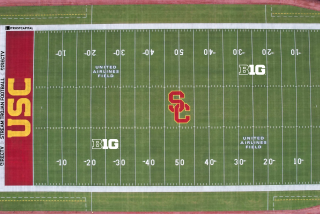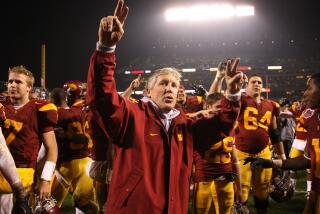Life After ‘Death’
DALLAS — Enter the trophy room at Southern Methodist University and feel what it must have felt to walk into a palace in which the royal family has hastily abdicated.
Monuments to a lost civilization stand and remaining artifacts tell of great triumphs, but Heritage Hall, as it is housed in meticulously kept, red-bricked Gerald J. Ford Stadium, is a mausoleum.
And it doesn’t tell the whole story.
There is no curator to explain what happened after 1987, no cornerstone to commemorate the moment a government was toppled.
The words “death penalty” cannot be found in the written record and the acronym NCAA appears only in an exhibit honoring the basketball squad’s 1956 Final Four run.
What you can find are the black, high-top cleats once worn by running back Doak Walker, the 1948 Heisman Trophy winner.
There is homage paid to Don Meredith and “Mustang Mania” heydays from 1979 to 1984, but no mention of homage payments.
You come across a newspaper account of SMU’s 1935 national-championship season that ended on Jan. 1, 1936, with a 7-0 loss to Stanford in the Rose Bowl.
This year marks the 70th anniversary of SMU’s only visit to Pasadena.
It seems unlikely that the school will pay another.
If the lasting image of SMU football remains the T-shirts with the picture of a deceased Mustang, on its back, legs pointed skyward, then it’s fair to say the NCAA provided the buckshot.
Death came Feb. 25, 1987, when David Berst, then the NCAA’s director of enforcement, reciting a litany of egregious infractions, announced that the football program would be discontinued for the 1987 season.
The school, on its own, elected not to play in 1988.
At one point during the news conference, Berst collapsed and had to be carried from the SMU student center, apparently having succumbed to the weight of this rendering.
“Maybe the legend’s better than the real story,” Berst, now a vice president of the NCAA, said recently. “It’s hard to know what actually happened. I had a respiratory infection, but absolutely it was a very high-pressure situation for everyone.”
The NCAA had only recently enacted a “death penalty” provision in which it could shut down a program for repeated violations.
The NCAA used it that once, on SMU, and has never used it again.
In 1982, riding the “Pony Express” backfield of Eric Dickerson and Craig James, SMU finished 11-0-1 and No. 2 in the country, behind one-loss Penn State.
The Mustangs posted a 51-5-1 record from 1981 to 1984.
Then, as Meredith used to sing on ABC’s “Monday Night Football,” they turned out the lights.
And the party was over.
Since returning to the field in 1989, SMU has gone 51-136-3 with only one winning season, 6-5, in 1997.
It appeared that fourth-year Coach Phil Bennett might be the latest SMU casualty before the Mustangs closed out a 5-6 season with three straight wins, probably saving his job.
Only three seasons ago, in 2003, SMU finished 0-12.
So, nearly two decades after the program was shut down, SMU football is still paying for its trespasses.
“It’s like the nuclear bomb,” Bennett said in his office. “I mean it really is. Nobody knew the devastation.”
You didn’t need a law degree to understand the background.
For years, in a hyper-competitive caldron of college football in Texas, top players were paid by boosters in a sophisticated and well-oiled system of compensation.
Periodic, if not inevitable, NCAA probations were seen as the price of doing business.
At SMU, a small private college in Dallas that took its football seriously, the sanctions kept piling up.
Few would deny SMU deserved to be punished.
“You can read the depositions, all the findings, we earned what we got,” James, the former star tailback and now an ABC college football analyst, said. “It was rough. As a kid, you don’t have a clue what was happening. That doesn’t make it right. Everyone was doing it.”
The bottom started falling out in 1985, when the NCAA sanctioned the football program for the sixth time since 1958.
Even fat-cat boosters and SMU officials knew it was serious this time, and they actually convened in March 1985 to figure out a way to “wind down” the payments to players.
The problem, as recounted in David Whitford’s 1989 book on the scandal, “A Payroll to Meet: A Story of Greed, Corruption and Football at SMU,” was that players on the SMU roster were still owed money.
It was at this 1985 meeting that SMU millionaire booster Sherwood Blount famously told his colleagues, “You’ve got a payroll to meet.”
So the payments continued secretly.
The scheme unraveled in November 1986, when SMU linebacker David Stanley confessed to a Dallas television station that he had taken $25,000 from boosters.
More important, Stanley said he -- and, as it turned out, others -- had accepted money after the latest NCAA penalties had been rendered, which meant SMU was subject to the NCAA’s “death penalty” provision.
The story went national, investigative reporters poked through public records, and it was ultimately revealed that the payment scandal was condoned and/or known about by members of the SMU athletic department and the school president.
The cover-up reached the highest levels of Texas politics -- the governor’s mansion.
The NCAA infractions report could not have been less forgiving.
“Not only is Southern Methodist University a repeat major violator,” it stated in part, “but its past record of violations is nothing short of abysmal.”
There are still, of course, those who say the penalty was too harsh and a few who suspect rival universities of greasing the NCAA skids.
“We started beating the big schools and you just can’t do that,” James said.
Bennett, who was born in Texas and played at Texas A&M;, confesses that he was, at least peripherally, a part of this cesspool of scandal.
“The Southwest Conference was out of control, it truly was,” Bennett said. “But how many conferences have that many schools in the same state? Baylor, TCU, SMU, Rice, Houston, Texas, Texas A&M.;”
Bennett says the competition for players was cutthroat and extended beyond borders.
“Arkansas, hell, they were cheating as bad as anybody,” he said, “
Bennett has always wondered why only two schools, SMU and later Texas Christian, took the brunt of NCAA violations.
“I’m a Texas A&M; grad, I recruited against all of them,” Bennett says. “They can’t point fingers.... This was a buyer’s market, I’ll tell you right now. It was a sign of the times. And there was nobody void of it. I mean nobody: state universities, private schools. It just befuddles me that the two schools that get hit the hardest are two private schools, SMU and TCU.”
Few knew at the time what effect the sanctions would have on SMU.
Forrest Gregg, SMU’s first coach after the sanctions, was asked at an early rally whether SMU could get back to the Cotton Bowl within 10 years.
Gregg said it would be a lot fewer than 10 -- and the room erupted with cheers.
It has, in fact, been more than 20 years since SMU played in a bowl game.
Berst, of the NCAA, knew his organization had delivered a staggering punch.
“I think we certainly recognized it would be something that would impact for five to 10 years,” he said. “I don’t know we could have predicted the impact beyond.”
Fred Jacoby, Southwest Conference commissioner from 1982 to 1993, said there is a reason no other major college program has received the penalty.
“It was so severe, the NCAA has not enacted the penalty on another school,” Jacoby said. “I don’t think they ever will because it was so devastating.”
In major violations cases since SMU, the NCAA has elected to cut scholarships as a form of punishment.
In the last 20 years, powerhouse programs such as Alabama and Miami have been severely sanctioned for major violations, yet both have returned to the upper echelon.
Miami won 34 straight games and a national title in 2001, on the heels of probation, and Monday, Alabama will play in SMU’s old haunt, the Cotton Bowl.
Berst doesn’t agree with those who say that other schools deserved what SMU got.
“I don’t know that I can recite to you other cases that were similar,” he said. “Even if you had no so-called death penalty, I don’t think there were any other alternatives left. You were in a situation where they were multiple offenders.”
Berst says the SMU sanctions have been a deterrent.
“I think presidents now are quick to take control of those matters on their own campuses and often penalize themselves before the NCAA gets there,” he said.
Although no school since SMU has received the “death penalty,” Berst says the “availability of that kind of penalty is important.”
SMU’s fall as a football power was a two-part process.
When the Southwest Conference was disbanded after the 1995 season, SMU was discarded to the Western Athletic Conference, whereas Texas, Texas A&M;, Texas Tech and Baylor landed in the more prestigious, and newly configured, Big 12 Conference.
Bennett thinks the breakup of the Southwest Conference, almost a decade after the penalty, put SMU in a deeper hole.
“To think a school that’s working its way back in could, 10 years later, lose its identity,” he said, “to me, it was more devastating than the death penalty.”
After competing against other Texas teams for talent, SMU suddenly found itself in a conference that had few recruiting ties to the state and a schedule that included Boise State and Hawaii.
SMU has since upgraded to Conference USA and is now partnered with more geographically desirable opponents: Houston, Rice, Texas El Paso and Tulsa.
Bennett, who was named SMU coach in December 2001, did not always believe the program could recover. Friends told him he was crazy for leaving his assistant’s post at Kansas State.
Bennett remembers sitting alone in his office after one of his first spring practices and thinking, “What have I done?”
He doesn’t think that anymore.
He says SMU has made significant strides, and proudly points to this season handing rival Texas Christian its only regular-season defeat.
Bennett says SMU is poised to “be a player” again in college football.
“You’ll think we’re nuts,” Bennett said, “but we’re capable of one day being a Utah-type team because of our recruiting area.”
Bennett was referring to Utah, which in 2004 became the first non-BCS school to qualify for a major bowl -- capping an undefeated year with a victory over Pittsburgh in the Fiesta Bowl.
James also thinks his alma mater is a “diamond in the rough.” He says SMU can come back “because of Dallas.”
James said, “You’ve got the perfect environment for success ... if somebody could just get that snowball at the top of the mountain and then go down the hill.”
Jacoby, the former Southwest Conference commissioner, is not so sure, claiming the penalty might have been permanently punitive.
“It always affects the people that weren’t involved,” Jacoby said. “You’re always trying to recover.”
Jacoby thinks SMU can be successful “at a different type of level.”
Bennett is working to prove naysayers wrong and insists that once SMU tastes success again, it will not revert to bad habits.
“We are about as straight and narrow as you can get,” Bennett said. “Our compliance here is second to none. I tell my coaches, ‘If you ever have a doubt, don’t do it. If you want to get fired, do something that is a knowing violation.’ ”
The NCAA’s actions against SMU, no doubt, helped curb corruption on college campuses.
People at SMU ask: At what price?
“We were sacrificial lambs,” Bennett said.
Those almost seem like Wild West days.
Bennett says he attends church with Blount, the booster who caused SMU so much trouble so many years ago.
“Sherwood is a different man than he was 20 year ago,” Bennett said. “He’s got a different priority. He’s not involved at all.
“If anything good came out of this, in college football, it’s that boosters can’t be involved. They can’t meet [players], can’t see them, and that’s the way it had to be.”
More to Read
Go beyond the scoreboard
Get the latest on L.A.'s teams in the daily Sports Report newsletter.
You may occasionally receive promotional content from the Los Angeles Times.











